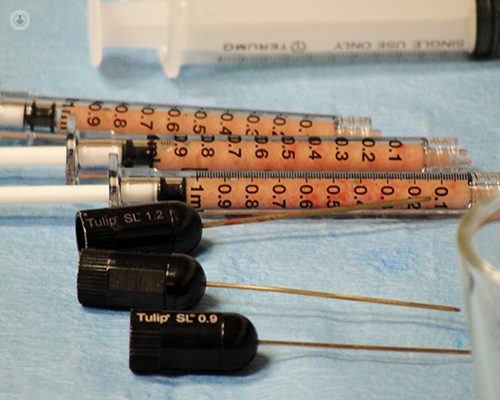


What is breast fat transfer?
Breast fat transfer, also known as fat grafting or an autologous fat transfer, is a fairly new breast reconstruction technique. In simple terms, a breast transfer involves removing fat from one part of the body, often the thighs, buttocks or abdomen, and injecting this fat into the breast area to reconstruct and recreate the breasts following breast cancer surgery. Whilst this is mostly an oncoplastic technique, it can be used as a means of ‘natural’ breast enhancement, without the need for implants.

Why is breast fat transfer done?
A breast fat transfer provides a means of both creating a more natural feeling and look breast enhancement. It is also a technique that can be used when reconstructing breasts that have undergone breast cancer surgery (e.g. a lumpectomy). If the breasts just need to have small differences fixed, a similar technique called lipofilling can be used. An advantage of this technique is that it can be safer than other means of breast augmentation or reconstruction because it is not major surgery, such as breast flap surgery, and it does not involve the risks of having a foreign object inserted (implants).
What does a breast fat transfer involve?
Fat is removed from another part of the body (buttocks, thighs or abdomen) using a thin tube which sucks out small amounts of fat. This process is similar to liposuction. Next, the fat must be prepared for insertion into the breast area. Specialist equipment spins the fat, separating the fat from the blood. Once the fat is prepared, it can be inserted into the breast area. Using a needle and syringe, fat is carefully transferred to the breasts. Stitches are usually not needed as the injections are inserted through very small holes.
A breast fat transfer can take up to two hours and sometimes it is done as a day case procedure, however, sometimes it may be necessary to stay in hospital overnight. It can be performed under either local or general anaesthetic, and whichever is used, there should not be any pain throughout the procedure. Sometimes, more than one session is required to achieve the desired results.
Preparation for a breast fat transfer:
Depending on the anaesthesia used, you may be required to fast before your procedure. Your health and suitability for breast fat transfer will also be determined before being scheduled for this procedure.
Aftercare:
After surgery, you should arrange for someone to take you home as you will not be able to drive initially. You can expect the breast area to be swollen and bruised for the first two weeks. Results are best observed a few months following breast fat transfer. Over time, it is normal for some of the transferred fat to be reabsorbed by the body, so some breast volume may be lost eventually. During your recovery period, it is advised that you do not sleep on your front and that you avoid strenuous activity.